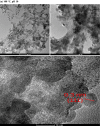Synthesis and defect characterization of hybrid ceria nanostructures as a possible novel therapeutic material towards COVID-19 mitigation
- PMID: 35228568
- PMCID: PMC8885868
- DOI: 10.1038/s41598-022-07200-9
Synthesis and defect characterization of hybrid ceria nanostructures as a possible novel therapeutic material towards COVID-19 mitigation
Abstract
This study reports the synthesis of hybrid nanostructures composed of cerium dioxide and microcrystalline cellulose prepared by the microwave-assisted hydrothermal route under distinct temperature and pH values. Their structural, morphological and spectroscopic behaviors were investigated by X-Rays Diffraction, Field Emission Gun Scanning Electron Microscopy, High-Resolution Transmission Electron Microscopy, and Fourier-Transform Infrared, Ultraviolet-Visible, Raman and Positron Annihilation Lifetime spectroscopies to evaluate the presence of structural defects and their correlation with the underlying mechanism regarding the biocide activity of the studied material. The samples showed mean crystallite sizes around 10 nm, characterizing the formation of quantum dots unevenly distributed along the cellulose surface with a certain agglomeration degree. The samples presented the characteristic Ce-O vibration close to 450 cm-1 and a second-order mode around 1050 cm-1, which is indicative of distribution of localized energetic levels originated from defective species, essential in the scavenging of reactive oxygen species. Positron spectroscopic studies showed first and second lifetime components ranging between 202-223 ps and 360-373 ps, respectively, revealing the presence of two distinct defective oxygen species, in addition to an increment in the concentration of Ce3+-oxygen vacancy associates as a function of temperature. Therefore, we have successfully synthesized hybrid nanoceria structures with potential multifunctional therapeutic properties to be further evaluated against the COVID-19.
© 2022. The Author(s).
Conflict of interest statement
The authors declare no competing interests.
Figures









Similar articles
-
High-throughput continuous hydrothermal synthesis of nanomaterials (part II): unveiling the as-prepared CexZryYzO2-δ phase diagram.ACS Comb Sci. 2013 Sep 9;15(9):458-63. doi: 10.1021/co3001346. Epub 2013 Aug 20. ACS Comb Sci. 2013. PMID: 23902344
-
Photocatalytic decomposition effect of erbium doped cerium oxide nanostructures driven by visible light irradiation: Investigation of cytotoxicity, antibacterial growth inhibition using catalyst.J Photochem Photobiol B. 2018 Aug;185:275-282. doi: 10.1016/j.jphotobiol.2018.06.011. Epub 2018 Jun 21. J Photochem Photobiol B. 2018. PMID: 30012250
-
Dopant-mediated oxygen vacancy tuning in ceria nanoparticles.Nanotechnology. 2009 Feb 25;20(8):085713. doi: 10.1088/0957-4484/20/8/085713. Epub 2009 Feb 3. Nanotechnology. 2009. PMID: 19417474
-
Shape-controlled ceria-based nanostructures for catalysis applications.ChemSusChem. 2013 Oct;6(10):1821-33. doi: 10.1002/cssc.201300428. Epub 2013 Sep 23. ChemSusChem. 2013. PMID: 24115732 Review.
-
Nanoscience and quantum science-led biocidal and antiviral strategies.J Mater Chem B. 2021 Sep 22;9(36):7328-7346. doi: 10.1039/d0tb02639e. J Mater Chem B. 2021. PMID: 34378553 Review.
Cited by
-
Positron Annihilation Lifetime Spectroscopy as a Special Technique for the Solid-State Characterization of Pharmaceutical Excipients, Drug Delivery Systems, and Medical Devices-A Systematic Review.Pharmaceuticals (Basel). 2023 Feb 7;16(2):252. doi: 10.3390/ph16020252. Pharmaceuticals (Basel). 2023. PMID: 37259399 Free PMC article. Review.
-
Ce-based solid-phase catalysts for phosphate hydrolysis as new tools for next-generation nanoarchitectonics.Sci Technol Adv Mater. 2023 Sep 8;24(1):2250705. doi: 10.1080/14686996.2023.2250705. eCollection 2023. Sci Technol Adv Mater. 2023. PMID: 37701758 Free PMC article.
-
Facile aqueous synthesis and comparative evaluation of TiO2-semiconductor and TiO2-metal nanohybrid photocatalysts in antibiotics degradation under visible light.RSC Adv. 2023 Nov 10;13(47):33187-33203. doi: 10.1039/d3ra06231g. eCollection 2023 Nov 7. RSC Adv. 2023. PMID: 37954413 Free PMC article.
-
Temperature dependent microstructural defects and surface charge effects on antioxidant activity of green synthesized nanoceria.Sci Rep. 2025 Aug 8;15(1):29110. doi: 10.1038/s41598-025-14654-0. Sci Rep. 2025. PMID: 40781350 Free PMC article.
-
Electric Properties Change during Morphological Evolution of CeO2 Nanostructures: Synergy between Bulk and Surface Defects.ACS Omega. 2024 Oct 3;9(41):42172-42182. doi: 10.1021/acsomega.4c03210. eCollection 2024 Oct 15. ACS Omega. 2024. PMID: 39431077 Free PMC article.
References
-
- Munster VJ, Koopmans M, van Doremalen N, van Riel D, de Wit E. A novel coronavirus emerging in China: Key questions for impact assessment. N. Engl. J. Med. 2020;382:692–694. - PubMed
-
- Zinatloo-Ajabshir S, Morassaei MS, Amiri O, Salavati-Niasari M. Green synthesis of dysprosium stannate nanoparticles using Ficus carica extract as photocatalyst for the degradation of organic pollutants under visible irradiation. Ceram. Int. 2020;46:6095–6107.
-
- Etemadi H, Afsharkia S, Zinatloo-Ajabshir S, Shokri E. Effect of alumina nanoparticles on the antifouling properties of polycarbonate-polyurethane blend ultrafiltration membrane for water treatment. Polym. Eng. Sci. 2021;61:2364–2375.
Publication types
MeSH terms
Substances
Grants and funding
- 2018/20590-0/Fundação de Amparo à Pesquisa do Estado de São Paulo
- 13/07296-2/Fundação de Amparo à Pesquisa do Estado de São Paulo
- 13/07296-2/Fundação de Amparo à Pesquisa do Estado de São Paulo
- 001/Coordenação de Aperfeiçoamento de Pessoal de Nível Superior
- PICT 2015- 1832/Agencia Nacional de Promoción Científica y Tecnológica
LinkOut - more resources
Full Text Sources

